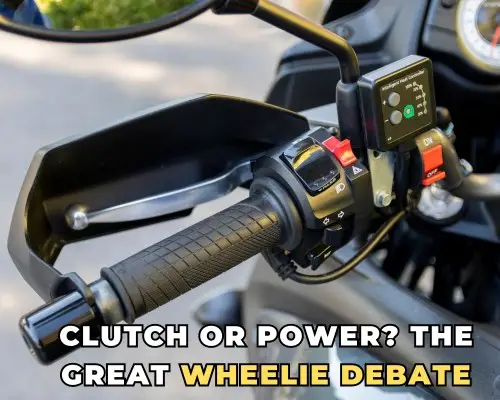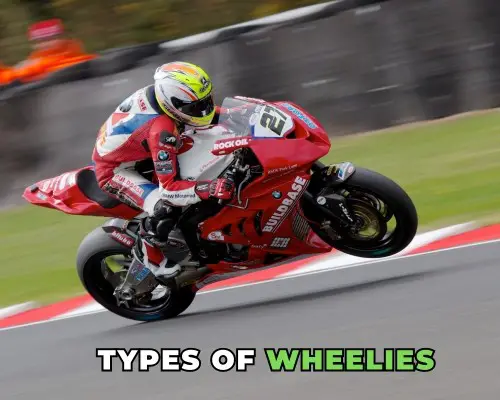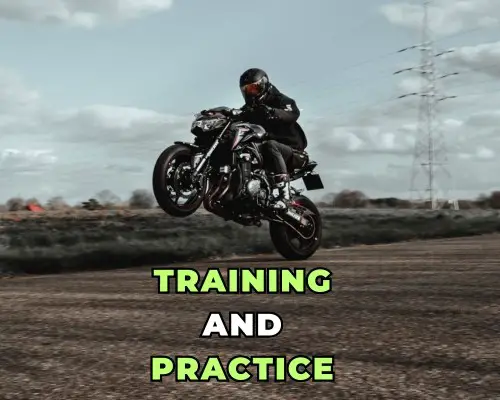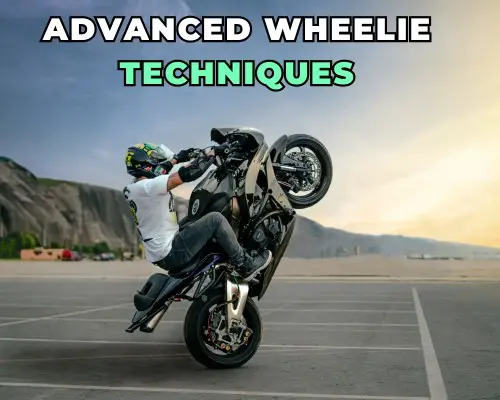How do you pop the perfect wheelie? It’s a question that splits the biking community right down the middle. Some swear by the clutch, quick and controlled.
Others advocate for sheer power, the throttle’s brute force. It’s not just about showing off. The choice can affect your ride’s feel, your bike’s wear, and yes, your street cred.
What’s your biggest wheelie challenge? Fear of flipping back too far? Struggling to find that balance point? Or is it mastering the clutch technique without stalling or, worse, damaging your beloved ride? These aren’t trivial concerns.
They dictate the joy and safety of your ride. Whether you’re in an empty parking lot or showcasing in front of an audience, the debate continues. Choose wisely, as your bike’s longevity might just depend on it.
Clutch or Power? Guide for a perfect Wheelie

Clutch-Up Wheelies: The Case for Control
When mastering wheelies, the clutch-up method is favored for its predictability and consistency. Here, you engage the clutch, rev the engine slightly, then release the clutch rapidly.
This action provides a controlled lift of the front wheel, enabling more precise handling. Seasoned riders find this technique allows better control over the bike’s balance point, crucial for maintaining steady speed and altitude without over-revving.
Practicing clutch-up wheelies enhances your ability to modulate throttle and brake inputs simultaneously.
This skill is vital for performing more advanced stunts safely and competently. Riders value the reproducibility of this method, as it tends to offer the same results with each attempt, given the same gear and approach.
Power Wheelies: The Role of Raw Force
On the other hand, power wheelies rely solely on the bike’s throttle. This method is less about finesse and more about sheer force.
You simply open the throttle sharply to lift the front wheel. While this might seem easier, it lacks the finesse and adjustability of clutch-ups.
Power wheelies often lead to what stunt riders call “chasing the wheelie.” This occurs when the rider has to continuously increase speed to maintain the wheelie, leading to potentially unsafe speeds.
There’s a significant risk of losing control, especially for beginners who might find the sudden burst of speed and elevation difficult to manage.
Safety and Showmanship
Safety is a prominent concern with both techniques. Clutch-up wheelies allow for more controlled environments, reducing the likelihood of accidents due to over-speeding or imbalance.
They are particularly useful in maintaining a wheelie at a constant speed, which looks more impressive and is generally safer.
Conversely, power wheelies can be unpredictable. The rider might find themselves accelerating too quickly, which can be intimidating and dangerous, especially in crowded areas or at high speeds.
Contextual Advantage of Each Technique
Each method has its context where it shines. For instance, in wet conditions, power wheelies might be preferable as the smoother application of power can prevent the rear wheel from slipping.
However, for stunt riding and controlled environments, clutch-ups are superior due to their reliability and the fine control they offer over the bike’s dynamics.
Types of Wheelies – Clutch or Power

Clutch-Up Wheelies Explained
- Mechanism: Initiate a clutch-up wheelie by revving the engine with the clutch disengaged, then abruptly engaging it. This action, often called “dumping the clutch,” transfers immediate power to the rear wheel, causing the front to lift.
- Suitability: Essential for bikes with lower power profiles that can’t achieve wheelies through throttle alone.
- Considerations: Be aware, that this method stresses the bike’s mechanicals—especially the clutch and transmission. I’ve seen more than a few enthusiasts face unexpected repairs from frequent clutch-ups.
- Skills Required: Timing is everything. Too slow on the clutch release, and you’ll get nothing but a loud engine. Too fast, and you might find yourself looking up from the pavement. Practice the ‘feather touch’—a delicate balance between clutch and throttle.
Power Wheelies Explained
- Mechanism: Achieved by simply opening the throttle. The bike’s raw power does the work, lifting the front wheel.
- Suitability: Ideal for high-powered motorcycles where a slight twist sends the front wheel skyward.
- Challenges: It’s all about throttle finesse—too much and you’re on your back, too little and the front wheel scoffs at your attempt. The real trick is mastering your bike’s balance point, which can feel like trying to find the horizon at sea.
- Beginner Tips: Start slow. Increase throttle incrementally to feel out the balance point. And remember, every bike has its personality. What works on one might get you in trouble on another.
Hybrid Techniques: Combining Elements for Advanced Tricks
- Description: This advanced style mixes clutch and power wheelies. You might start with a clutch pop to get the front up, then maintain it with careful throttle control.
- Complexity: This is where art meets skill. It’s not just mechanical; it’s rhythmic, almost like a dance with your bike.
- Advantages: Hybrid techniques allow for stunning displays that can be adjusted mid-performance, offering a spectacle of control and flair.
- Examples: A favorite among seasoned riders is the transition from a high clutch-up into a long, smooth power hold. It’s impressive and showcases the true mastery of wheelie control.
Enhancing Your Wheelie Execution
- Personal Insight: In my early days, wheelies were a hit-or-miss. Now, they’re a thoughtful calculation. Each bike I’ve ridden taught me something new about how wheelies can vary. It’s about understanding and feeling the bike as an extension of yourself.
- Practice: There’s no substitute for practice, but make it count. Focus on consistent, incremental improvements and set realistic goals each session.
- Safety Gear: I’ve learned from, let’s say, painful experiences, that the right gear matters immensely. Don’t skimp on helmets, gloves, or jackets. They’re your best friends in the fall.
- Maintenance: Regular checks on your bike’s clutch, brakes, and suspension not only improve performance but also prevent those heart-stopping moments when something fails at high speed.
Training and Practice – The Ultimate Wheelie Guide to Achieve Mastery

Structured Practice Sessions: Building Skill Over Time
- Approach: Mastering wheelies is akin to learning a musical instrument. It demands patience, persistence, and a methodical breakdown of every move.
You wouldn’t expect to play Beethoven overnight, right? Likewise, structured practice sessions are designed to build your skills gradually but effectively.
- Example Programs:
- Superbike-Coach Wheelie Course: Imagine being coached by the best, where every nuance of your technique is honed.
Here, you practice throttle control, balance, and clutch pulls, moving from simple drills to complex maneuvers, all under the watchful eyes of expert coaches.
- RLC Online MTB Coaching’s 30-Day Wheelie Challenge: Perfect for those who prefer a step-by-step approach. It starts simple and builds up. By day 30, you’re not just lifting the front wheel; you’re cruising in style.
- Benefits: Like a chef perfecting his knife skills, every session sharpens your abilities. This focused practice embeds muscle memory, which is crucial for pulling off smooth, consistent wheelies.
Feedback and Improvement: Learning from Each Attempt
- Continuous Learning: Each wheelie attempt, successful or not, is a treasure trove of lessons. Like watching instant replay in sports, analyzing what went right or wrong is how you refine your skills.
- Feedback Sources:
- Coaching Feedback: In programs like Superbike-Coach, feedback isn’t just commentary—it’s a pathway to excellence. Coaches provide insights that transform average riders into stunt savants.
- Community Input: On forums like Reddit, every thread is a classroom. Riders share their wheelie woes and wins, offering a community-driven roadmap to wheelie mastery.
- Utilizing Feedback: Adjust, adapt, and try again. Feedback is your guide. Each tweak based on a coach’s advice or a fellow rider’s tip could be the key to your next breakthrough.
Community and Learning: Joining Groups and Watching Pros
- Community Engagement: Imagine joining a club where everyone shares your passion for wheelies.
RLC Online MTB Coaching’s Facebook group isn’t just a social network—it’s a brain trust of wheelie wizards where tips, support, and challenges flow freely.
- Learning from Professionals:
- Watching Experts: There’s something magical about watching a pro effortlessly pull a wheelie. YouTube channels like “Better Wheelies In 1 Day” not only provide visual guides but also push the boundaries of what you think is possible.
- Hands-On Learning: Superbike-Coach’s wheelie school is more than just a course—it’s an immersive experience. Bringing your bike or renting a wheelie-specific model, you get a feel for different setups and direct feedback that is tailored to your riding style.
- Advantages of Community Learning: It’s not just about the tricks; it’s about the ties you form. Learning within a community brings shared challenges to light, making overcoming them a collective triumph. Plus, nothing beats the rush of shared excitement when you and a group mate nail a new trick for the first time.
Integrating structured learning, insightful feedback, and an active community into your practice routine not only sharpens your skills but also deepens your love for the sport.
This holistic approach ensures that every practice session enriches your understanding and enhances your performance, turning every wheelie into a statement of skill and every ride into a testament to progress.
Advanced Wheelie Techniques

Stoppies and Other Stunts: Building on Wheelie Skills
- Progression to Stoppies: Just as I thought mastering wheelies was tough, stoppies challenged my skills even further.
The technique requires accurate braking force and great balance because it involves lifting the rear wheel by applying the front brake hard. It’s not for the timid—think of it like tightrope walking and juggling!
- Skills Enhancement: Transitioning from wheelies to stoppies isn’t just about switching from rear to front. It’s about refining your understanding of your bike’s dynamics.
Your throttle control has to be impeccable, and your braking? Even more so. This knowledge drastically improves your handling of all kinds of stunts.
- Stunt Synergy: Every new stunt learned is like adding a new tool to your toolkit. As these tools multiply, your capacity for creating spectacular, complex stunt combinations increases exponentially. Think of it as expanding your vocabulary in the language of motorbike stunts.
Combining Wheelies with Other Tricks for Competitions
- Competition Dynamics: Remember the first time you watched a stunt rider seamlessly transition from a wheelie into a 360 spin? It was probably breathtaking.
In competitions, this is the level of performance that garners top scores. Integrating wheelies with other dynamic movements showcases a rider’s control and innovation, turning a routine into a showstopper.
- Showcasing Versatility: During a competition, judges look for that spark—something that sets you apart.
Incorporating wheelies into your routines shows you’re not just skilled, but also creative and versatile. It’s about turning technical prowess into an art form.
- Practical Tips: Start by mastering each component separately, then slowly stitch them together. A wheelie into a jump might sound daunting, but with incremental practice, it becomes second nature. Ensure each transition is as smooth as silk to keep the flow alive.
Sequences and Routines for Stunt Riding
- Choreographed Performances: Creating a routine is like choreographing a dance. Each movement must be fluid, each transition sharp.
When I choreograph my routines, I visualize each stunt not just as a trick, but as a beat in a larger rhythm. This approach ensures that the performance is cohesive and enthralling.
- Developing Routines: Lay out your routine like a storyboard for a film, where each stunt is a scene that must connect fluidly to the next.
Practice each transition until it’s muscle memory. This meticulous planning and repetition ensure your performance flows naturally, keeping your audience hooked from start to finish.
- Enhancing Performance: Rigorous practice is undeniable, but watching and learning from other pros can provide invaluable insights.
Try filming your practices; watching yourself can reveal flaws in timing or execution that aren’t always felt in the moment.
Plus, regular reviews with a coach or mentor can provide feedback that transforms good routines into great ones.
By deeply understanding and integrating these advanced techniques, your capabilities will not just expand; they will evolve.
The journey from mastering simple wheelies to performing complex stunts is filled with challenges and exhilarations, but each step forward is a thrilling leap toward becoming a true master of the craft.
Remember, in the world of stunt riding, every practice, every fall, and every triumph is a step toward greatness.
As an Amazon Associate, I earn from qualifying purchases, at no additional cost to you. Read Our Affiliate Disclosure.

